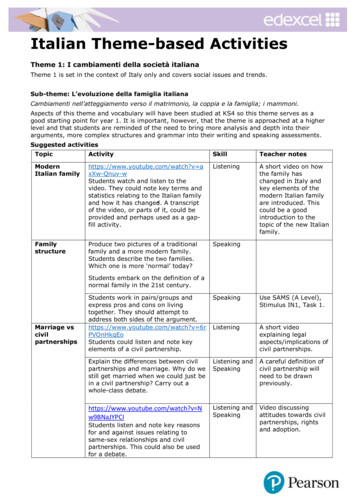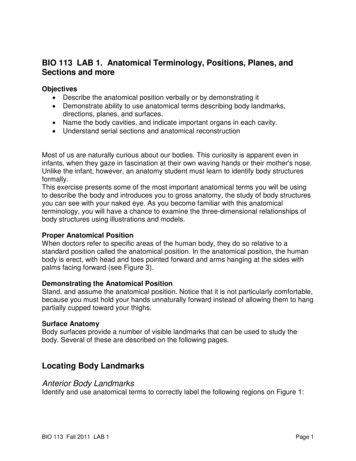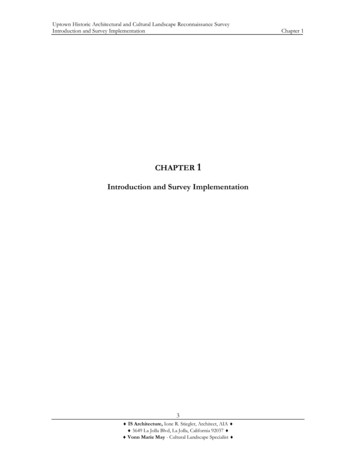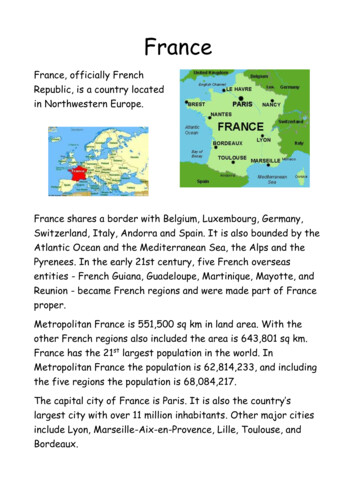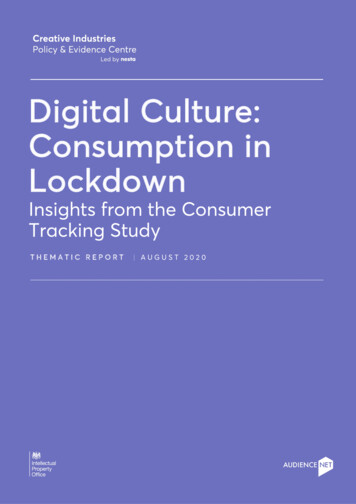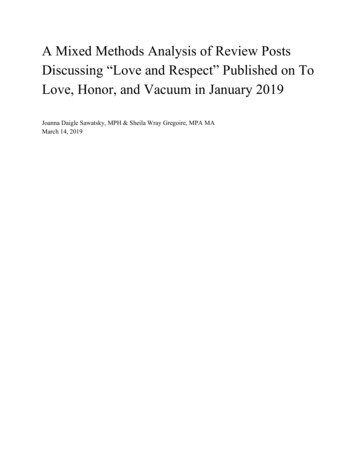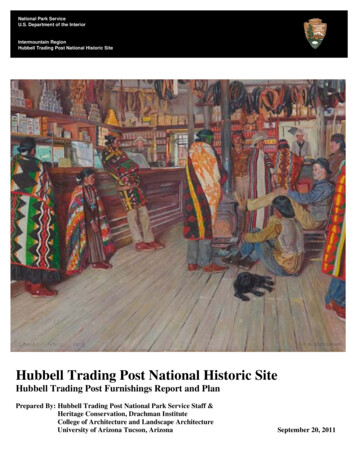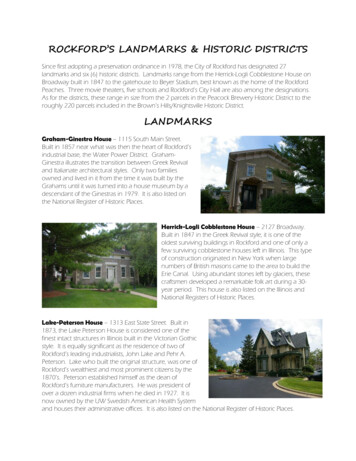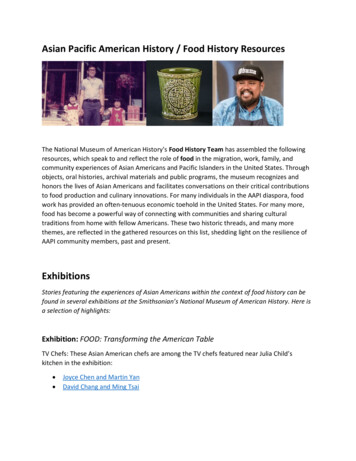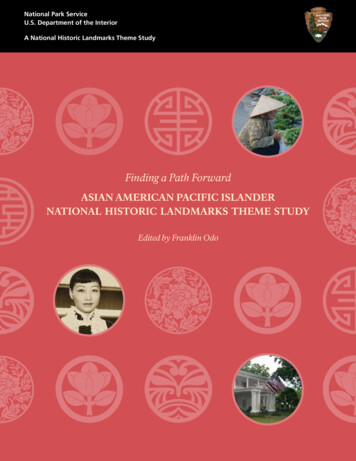
Transcription
National Park ServiceU.S. Department of the InteriorA National Historic Landmarks Theme StudyFinding a Path ForwardASIAN AMERICAN PACIFIC ISLANDERNATIONAL HISTORIC LANDMARKS THEME STUDYEdited by Franklin Odo
Use of ISBNThis is the official U.S. Government edition of this publication and is herein identified tocertify its authenticity. Use of 978-0-692-92584-3 is for the U.S. Government PublishingOffice editions only. The Superintendent of Documents of the U.S. Government Publishing Office requeststhat any reprinted edition clearly be labeled a copy of the authentic work with a new ISBN.Library of Congress Cataloging-in-Publication DataNames: Odo, Franklin, editor. National Historic Landmarks Program (U.S.),issuing body. United States. National Park Service.Title: Finding a Path Forward, Asian American and Pacific Islander NationalHistoric Landmarks theme study / edited by Franklin Odo.Other titles: Asian American and Pacific Islander National Historic Landmarkstheme study National historic landmark theme study.Description: Washington, D.C. : National Historic Landmarks Program, NationalPark Service, U.S. Department of the Interior, 2017. Series: A NationalHistoric Landmarks theme study Includes bibliographical references andindex.Identifiers: LCCN 2017045212 ISBN 9780692925843 ISBN 0692925848Subjects: LCSH: National Historic Landmarks Program (U.S.) AsianAmericans--History. Pacific Islander Americans--History. UnitedStates--History.Classification: LCC E184.A75 F46 2017 DDC 973/.0495--dc23 SUDOC I29.117:AS 4LC record available at https://lccn.loc.gov/2017045212For sale by the Superintendent of Documents, U.S. Government Publishing OfficeInternet: bookstore.gpo.gov Phone: toll free (866) 512-1800; DC area (202) 512-1800Fax: (202) 512-2104 Mail: Stop IDCC, Washington, DC 20402-0001ISBN 978-0-692-92584-3iiAAPI National Historic Landmarks Theme Study
Essay 14Asian American Activism and Civic Participation:Battling for Political Rights and Citizenship, 1917 to the PresentDaryl Joji MaedaUniversity of Colorado, BoulderIn the early 20th century, Asian immigrants were denied citizenship,and even American-born citizens of Asian ancestry suffered from systematic legal, social, and economic discrimination that relegated themto second-class citizenship. Scorned as a “Yellow Peril” that threatenedthe economic and moral fabric of the nation from the mid-19th centuryto the mid-20th century, they were transformed into the so-called “modelminority” during the Cold War yet still faced prejudice and violence. Overthe past century, Asian Americans have battled for equal inclusion in theUnited States, participated actively in the political and judicial process-es that define the nation, and mobilized grassroots efforts that sought tobetter the living and working conditions of poor and working-class people. People of many different Asian ancestries have come together in theU.S. under the umbrella category of “Asian American”—a term coined inJack Maki, regional specialist for Japan Far East Section, Overseas Branch, Office ofWar Information. Despite the incarceration suffered by West Coast Japanese Americans,individuals like Maki were able to find good opportunities during the war.Photo by Esther Bubley, 1943; courtesy of the Library of Congress.Asian American Activism and Civic Participation: Battling for Political Rights and Citizenship, 1917 to the Present271
the 1960s to unite groups with diverse ethnicities, cul-1905, it severely curtailed Korean emigration, and Kore-tures, languages, and nations of origin in alliances forans, as subjects of Japan, were barred under Japanesesocial justice.exclusion. Historians Yuji Ichioka and Eiichiro Azumahave detailed widespread community efforts to combatEXCLUSION AND BARS TO NATURALIZATIONexclusion by Japanese Americans, who appealed, largelyBy 1917, Asians were largely barred from immigrating tounsuccessfully, to both the Japanese and U.S. govern-the U.S. An active and powerful anti-Asian movementments to protect their rights.successfully targeted Chinese, Japanese, Asian Indians,Asian Indians migrated to the U.S. in small num-and Filipinos for exclusion. The Page Law of 1875, thebers in the early 20th century, but were confronted byfirst anti-Asian immigration act, prohibited “Chinese,exclusionists, who included them in the ranks of theJapanese, and Mongolian women” from entering theundesirables, with the Japanese and Korean ExclusionUnited States “to engage in immoral or licentiousLeague, renaming itself the Asiatic Exclusion League inactivities.” Although it was intended to combat the1907. Indian immigration ended with the passage of theimportation of prostitutes, officials enforced it under1917 Immigration Act, which created an “Asiatic Barredthe presumption of poor moral character of all AsianZone” that included the Indian subcontinent. But aswomen attempting to immigrate. Hence, the Page LawSeema Sohi has shown, South Asian migrants used theeffectively resulted in a de facto bar on immigration ofUnited States as a base for radical social movementsChinese women. The Chinese Exclusion Act of 1882organizing that pursued ambitious goals, including end-bestowed upon the Chinese the dubious distinction ofing the British occupation of India.2being the first people to be specifically barred, on theThe 1924 Immigration Act, also known as thebasis of their race or nationality, from immigrating toJohnson-Reed Act, tied immigration to eligibility forthe U.S. It prohibited the migration of Chinese laborers,citizenship by barring the immigration of aliens raciallywho were by far the bulk of Chinese immigrants, and soor nationally ineligible to naturalization, a category thateffectively ended Chinese immigration.applied to Chinese, Japanese, Koreans, and IndiansWhile the flow of Chinese workers was largely(Filipinos continued to be admissible because the Philip-stanched, the need for the labor they provided contin-pines was an American colony). The 1790 Naturalizationued unabated, and Japanese began immigrating in largeAct and the Civil Rights Act of 1870 reserved natural-numbers in 1885. The 1907 to 1908 Gentlemen’s Agree-ization to “free white persons” and persons of “Africanment formed the mechanism for Japanese exclusion.nativity or descent,” respectively. Because neither lawSchool officials in San Francisco had decreed that Jap-enumerated Asians, the eligibility of Asians to naturaliza-anese students had to attend segregated public schoolstion rested on a number of court decisions in what thewith Chinese rather than whites. (The mere existencelegal historian Ian Haney Lopez has termed the “prereq-of public education for Chinese was itself the resultuisite cases.”3of litigation by Chinese Americans in Tape v. HurleyAsian Americans vociferously and repeatedly(1885), which forced the San Francisco school district topursued citizenship rights through the courts, beginningenroll Chinese students, though the Board of Educationin the late 19th century. A Chinese immigrant namedchose to comply by enforcing segregation.1) To avoid anAh Yup applied for naturalization but was denied byinternational incident with Japan, President Theodorethe Federal District Court of California, which decreedRoosevelt pressured school officials to rescind theirthat as a member of the “Mongolian race,” he was notorders, segregating Japanese students with the Chinese;a “white person” and therefore was ineligible to natu-in return, the Japanese government agreed to ceaseralization (In re Ah Yup, 1878). During World War I, aissuing exit visas to Japanese laborers bound for thelaw called the “Act of May 9, 1918,” encouraged aliens toU.S. However, Japanese women continued to migrate asjoin the military in exchange for the promise of natu-picture brides until 1920, when the U.S. again pressuredralization. In 1921, a Korean American veteran, EasurkJapan – this time to stop allowing women to join theirEmsen Charr, petitioned for naturalization under thehusbands in the U.S. After Japan colonized Korea inAct but was denied because the federal District Court272AAPI National Historic Landmarks Theme Study
of Western Missouri deemed him to be a member of theWORLD WAR II AND THE COLD WAR:“Mongol family.” The eligibility of Japanese was testedTRANSITION TO THE MODEL MINORITYby Takao Ozawa, a well-assimilated Japanese immigrantDecades of exclusion and discrimination culminated inof impeccable character, who applied for naturalizationthe incarceration of Japanese Americans during Worldin 1914 but was denied. The push to advance Ozawa’sWar II. But even as the war had disastrous consequencescase to the Supreme Court was broadly supported by thefor Japanese Americans, it opened opportunities for oth-Japanese American community and widely covered iner Asian Americans. From 1943 to 1965, Asian Americansthe immigrant press. Indeed, Ozawa had been selectedenjoyed a number of victories in areas including immi-as an ideal subject for a test case by the Pacific Coastgration and naturalization and social acceptance. 6Japanese Association Deliberation Council, a confeder-Wartime geopolitics impacted the fates of Asianation of Japanese Associations throughout the westernAmericans in multiple ways. The World War II align-U.S. and Canada, which hired former U.S. Attorneyment of the United States with China, the Philippines,General George Wickersham to represent the communi-and India as allies against Japanese imperialism crackedty’s interest. In 1922, the Supreme Court ruled in Ozawathe edifice of exclusion. During the war, the Californiav. United States that Takao Ozawa was ineligible forAttorney General reinterpreted alien land laws to enablenaturalization, being neither “Caucasian” nor of AfricanFilipinos to lease agricultural land, often the abandoneddescent. The very next year, the Supreme Court tookfarms of Japanese Americans sent to concentrationup the case of Bhagat Singh Thind, an Indian immigrantcamps.7 With the Chinese now seen as brave resisterswho had been naturalized in 1920 due to his service inagainst the hated Japanese, rather than racial undesir-the U.S. military during World War I. Federal officialsables, Congress repealed the Chinese exclusion in 1943sought to deport Thind because he was an advocatewith the passage of the Magnuson Act, which allotted aof Indian independence from Great Britain but had tomeager quota of 105 Chinese immigrants per year but,strip him of citizenship in order to do so. The Supremeperhaps more importantly, enabled Chinese immigrantsCourt ruled in United States v. Bhagat Singh Thind (1923)to be naturalized. Similarly, in 1946, the Luce-Celler Actthat Thind, who claimed he was “Caucasian,” was notended Filipino and Indian exclusion, designating eachwhite according to “the understanding of the commongroup an annual quota of 100 immigrants and legalizingman” and thus ineligible to naturalization. In 1925, thetheir naturalization. It is important to note the minusculeSupreme Court ruled in Toyota v. United States thatsize of these quotas in comparison to those designatedFilipinos who had served in the military during Worldfor Europeans.4War I were eligible for naturalization under the Act ofThe rapid transition from World War II to theMay 9, 1918, but were otherwise ineligible to naturaliza-Cold War similarly reoriented U.S. treatment of Asiantion. Though unsuccessful, these cases demonstrate theAmericans. Japan experienced a dizzying transforma-determination with which Asian immigrants sought totion from being seen as a bloodthirsty conqueror to aattain citizenship.domesticated junior partner of the U.S. in the struggleOne of the chief economic results of being deniedagainst communism. The 1952 McCarran-Walter Actnaturalization was that Asian immigrants fell prey tonullified Japanese exclusion, granting Japan an annualAlien Land Laws enacted in California, Oregon, Wash-quota of 185 immigrants and other Asian nations quotasington, Idaho, Arizona, New Mexico, Utah, and otherof 100. Most importantly, it abolished the racial bar tostates. These laws were tailored to bar Asian immigrantsnaturalization, making all Asians eligible for citizenship.from owning land and property, which had particularlyAlthough these affordances constituted major advancesharmful effects on immigrant communities whose econ-in Asian American civil rights, the bill also containedomies were based on agriculture. Litigants challengedprovisions barring the entry of suspected subversivesthe legality of the Alien Land Laws, taking their cases toand deportation of aliens and naturalized citizens sus-the U.S. Supreme Court, which upheld their constitu-pected of communism. The Japanese American Citizenstionality in four cases decided in 1923.5League lobbied strongly for the passage of the Act, whileAsian American progressives opposed it. PresidentAsian American Activism and Civic Participation: Battling for Political Rights and Citizenship, 1917 to the Present273
Truman vetoed the bill over civil liberty concerns, butemergence of the “model minority” representation ofCongress overrode his veto. Four years later, CaliforniaAsian Americans is generally dated to 1966, when therepealed its Alien Land Laws, a symbolic act given thatNew York Times Magazine published William Petersen’sthe McCarran-Walter Act had effectively negated the“Success Story, Japanese-American Style,” a laudato-category of aliens ineligible to citizenship.ry tale of Japanese Americans overcoming prejudiceIn Hawai‘i, long governed by a white planta-through hard work, education, family values, and strongtion-owning elite, Asian Americans surfed the postwarcommunities. U.S. News and World Report’s subsequentpolitical wave of the “Democratic Revolution of 1954”“Success Story of One Minority Group in U.S.” repeat-into the statehouse. Many of the newly elected officialsed these claims for Chinese Americans. Published inwere Japanese American veterans of World War II whothe midst of the Civil Rights Movement, these parableshad proven their patriotism by serving their country,contrasted Asian Americans’ purported meeknesseven while co-ethnics were locked away in concentra-(an extraordinarily untrue supposition) to increasingtion camps. Most notably, Daniel Inouye, who lost hisAfrican American militancy, posing Asian Americans asright arm in Italy fighting as a member of the legendarya model for other minorities to follow by arguing thatall-Nisei 442nd Regimental Combat Team, earned aequality is most effectively gained through educationseat in the Territorial House of Representatives andand industriousness rather than social protest.went on to serve in the U.S. Senate for 40 years. TheHonolulu-born Inouye gained fame for his role in theTHE GRASSROOTS ASIAN AMERICAN MOVEMENTWatergate hearings and chairing the Senate inquiryEven as the model minority representation lauded Asianinto the Iran-Contra scandal. Hawai‘i also elected PatsyAmericans for their supposed docility, a defiant socialMink—born in the tiny town of Paia, Maui—to Con-movement arose. Known as the Asian American move-gress in 1964, making her the first female Asian Americanment, this grassroots movement represented a breakto serve in the House of Representatives. As an ardentwith prior Asian American strategies of using courts,proponent of women’s rights and educational opportu-political lobbying, labor organizing, and ethnic mobili-nity, one of Mink’s signal accomplishments was writ-zation as means by which to fight for justice. The Asianing Title IX, which prohibits gender discrimination inAmerican movement emerged from the Black Power andhigher education.anti-Vietnam War movements, adopting an analysis thatThe Hart-Celler Act of 1965 represented a majorunderstood racism as a common ill shared by Asians ofbreakthrough in Asian American rights. Also known asall ethnicities in the U.S., declaring solidarity with blacks,the Immigration Act of 1965, it abolished the nationalLatinos, and American Indians, and positioning Asianorigins quota system that had underlain immigrationAmericans alongside “Third World” people around thepolicy since 1924. Under a racist wrinkle in the nationalorigins system, Asian immigrants were the only groupto be enumerated by ethnicity rather than nation. Forexample, an Indian person migrating from Londoncounted against India’s quota rather than Great Britain’s,whereas a British subject migrating from New Delhi alsocounted against India’s quota. Hart-Celler eliminatedthis unequal treatment of Asians and, in place of nationalquotas, established a system of preferences that aimed toreunify families and attract immigrants with desired jobskills. In the decades since 1965, Asian immigration hasskyrocketed and, as a result, remade the demographicsof Asian America and the United States itself.Popular representations of Asian Americans reflected the legal gains they made during the Cold War. The274AAPI National Historic Landmarks Theme StudyLocal 7 leaders Ernesto Mangaoang, Vincent Navea, and IrineoCabatit in the early 1940s. Photo courtesy of the Filipino AmericanNational Historical Society.
globe. It operated on college campuses, urban areas, andcountrysides from Hawai‘i to the east coast.8EARLY ORGANIZATIONSAsian American Political Alliance (AAPA) constitutedone of the most important early Asian American movement organizations. Formed in Berkeley in 1968 as aneffort to bring together progressive Asians of all ethnicities, AAPA grew out of the fertile soil of the New Left.Founder Yuji Ichioka coined the term “Asian American”in naming the new group; he and co-founder Emma Geerecruited members by combing the roster of the antiwarPeace and Freedom Party (which ran Black Pantherleader Eldridge Cleaver for President in 1968) for Asiansurnames. AAPA adopted anti-racism and anti-imperialism as its principles, locating Asian Americans as subjectsFounding members of the Cannery Workers' and Farm Laborers'Union Local 18257 obtain a charter from the American Federationof Labor 1933. Back left: Tony Rodrigo. Front left: Joe Mislang;President Virgil Duyungan. Front right: Frank Alonzo.Photo courtesy of the Filipino American National Historical Society.of racism alongside other people of color and condemning the Vietnam War as anti-Asian genocide.Asian Americans for Action (AAA), established inNew York City in 1968, shared many similarities withbombings of Hiroshima and Nagasaki and held demonstrations against the Vietnam War.Unlike AAPA, which began with college students,AAPA, but had key differences as well. Like AAPA, AAAthe Red Guard Party arose from the streets of Chi-drew from the Black Power and antiwar movements.natown in San Francisco. Despite the reputation ofIts two women founders, Kazu Iijima and Minn Masu-Chinatown as an exotic wonderland, Chinese Americanda, were inspired by the pride and militancy expressedyouth experienced chronic underemployment, substan-by leaders like H. Rap Brown and James Farmer, whodard education and social services, and regular policeharshly condemned U.S. racism and militarism. Theyharassment. A group called Legitimate Ways (Leways forrecruited members by scouting antiwar demonstrationsshort) opened in 1967, offering job training and oper-for Asian American participants, regardless of ethnicity.ating a pool hall as a recreational opportunity to keepBut unlike AAPA, which was composed of college-agedkids out of trouble. Leways attracted both street kidsstudents, AAA had ties to older generations of Asianand progressive Asian Americans who had imbibed theAmerican radicals. Iijima was a veteran of the Youngpolitics of the black power and antiwar movements. AlexCommunist League and had belonged to a JapaneseHing had grown up in Chinatown but left to attend SanAmerican progressive group called the New DemocratsFrancisco City College, where he joined Students for abefore World War II; Masuda shared Iijima’s historyDemocratic Society and later joined the Peace and Free-of prewar radicalism. Another older member was Yuridom Party. When he returned to Chinatown, he foundKochiyama, whose radicalism developed in New Yorka group of rapidly politicizing youth at Leways. Theafter the war. Kochiyama called Harlem in the 1960s “myBlack Panthers—famous for their analysis of racism as auniversity-without-walls,” at which she learned aboutsystemic problem impacting all non-white people—alsoblack struggles from leaders including Malcolm X. Hernoticed the rising militancy in Chinatown and invitedapartment in Harlem became a center of organizing andsome of the Leways members to study political theorya salon for progressive activists. Although Kochiyamawith them. The group formed the Red Guard Party withbecame the best-known Asian American radical, sheHing as its Minister of Information and announced theirremained thoroughly enmeshed in the struggles of blackpresence in April 1969. The Red Guards endorsed Maoand Puerto Rican peoples. AAA’s name bespoke its com-Tse-tung, called for the liberation of “yellow people”mitment to creating social change. Members protestedin a 10 Point Program, operated a Free Sunday Brunchagainst nuclear weapons by commemorating the atomicprogram for Chinatown elders, published the Red GuardAsian American Activism and Civic Participation: Battling for Political Rights and Citizenship, 1917 to the Present275
Community Newspaper, and provided draft counselinging the establishment of “schools of ethnic studies” forthat condemned the Vietnam War. One significant siteeach group, with students “having the authority and thefor the Red Guards was Portsmouth Square on the edgecontrol of the hiring and retention of any faculty mem-of Chinatown, where the group held rallies and protests.ber, director, and administrator, as well as the curricu-The conditions in New York City’s Chinatown mir-la.” In addition, they demanded 50 faculty positions berored those in San Francisco, with congested housing,allocated to ethnic studies, with 20 reserved for the Blacksubstandard healthcare, and endemic poverty. SomeStudies program. Finally, they demanded blanket admis-members of AAA and the Columbia University chaptersions for nonwhite applicants in fall of 1969, control overof AAPA formed a group called I Wor Kuen (IWK) andfinancial aid, and non-retaliation against faculty mem-opened a storefront in February 1969. IWK publishedbers. Throughout late 1968 and early 1969, TWLF did itsa newspaper, Getting Together, in English and Chinese,best to shut down the college with sit-ins, picket lines,operated a free health clinic, screened films laudingmass demonstrations, and various disruptions. The strikethe People’s Republic of China, and called for “Yellowreduced class attendance by as much as half at timesPower” that would lead to the “freedom and power forand even forced the temporary closure of campus, evenall non-white (YELLOW, BROWN, BLACK) peoples.”9though the authoritarian Acting President S. I. HayakawaIn 1971, the Red Guards and I Wor Kuen merged to formcalled in the San Francisco Police Department’s tacti-National I Wor Kuen, the first and eventually largestcal squad, which broke up rallies and conducted massnational Asian American revolutionary organization.arrests. Notable locations at SFSU include the cornerof 19th and Holloway Avenues, where Hayakawa wasCAMPUS ACTIVISMphotographed clambering onto a sound truck and pullingThe opening salvo of Asian American campus activismwires out of the amplifier to silence speakers (an imagewas fired at San Francisco State College (now University),that catapulted Hayakawa into the national conscious-an urban commuter campus in a diverse city with a longness as a conservative hardliner) and the central quadran-history of student activism. Throughout the 1960s, SFSCgle where the TWLF held daily rallies. After five monthsstudents supported the Civil Rights Movement, protestedof protest, organizing, and battling the police, the TWLFhearings of the House Un-American Activities Commit-settled with the administration. The agreement estab-tee, and demonstrated against the Vietnam War. Threelished a school of ethnic studies (albeit at far less facultyAsian American student groups aimed to make higherstrength than the strikers had demanded) but did noteducation more available and more relevant to their com-grant student control over hiring, curricula, or financialmunities. The largely Japanese American San Franciscoaid. The TWLF strike at SFSC continues to be the longestchapter of the Asian American Political Alliance (AAPA)student strike in U.S. history.operated in Japantown; the Intercollegiate Chinese forSocial Action (ICSA) in Chinatown; and the PilipinoAmerican Collegiate Endeavor (PACE) in the Mission,working on community issues including fights againstredevelopment, operating off-campus tutoring programs,and recruiting community members to college. In springof 1968, AAPA, ICSA, and PACE joined the Black StudentUnion, Latin American Student Organization, and Mexican American Student Confederation to form the ThirdWorld Liberation Front (TWLF), a multiracial alliancededicated to remaking the college in fundamental ways.Although the college had begun a Black Studies program,students found the pace of progress and the administration’s commitment of resources to be unsatisfactory.TWLF declared a strike on November 6, 1968, demand-276AAPI National Historic Landmarks Theme StudySam Mukaida leads fellow students at the University of Hawai’i insong during a special rally on the steps of Hawai’i Hall, saying Alohato Varsity Victory Volunteers, 25 February 1942. Photo #765, Hawai'iWar Records Depository; courtesy of the University Archives &Manuscripts Department, University of Hawai'i at Manoa Library.
East of San Francisco, across the Bay Bridge, stoodSeattle, the San Francisco Bay Area, Los Angeles, Newthe prestigious University of California, Berkeley,York, and Philadelphia. After the TWLF strike at Berke-widely known for the Free Speech Movement (1964)ley, some AAPA members came to believe that theyand antiwar protests. Berkeley students formed theircould make a greater contribution by working withinown Third World Liberation Front, which was inspiredthe community and thus created the Asian Communityby and ideologically aligned with the SF State version,Center (ACC). To improve living conditions in China-but organizationally distinct. The Berkeley TWLFtown, ACC operated a free food program that distrib-was comprised of Cal student groups including theuted food to 300 people per month and a free healthAfro-American Student Union (AASU), the Berkeleyclinic that screened elders without health insurance forchapter of the Asian American Political Alliance (AAPA),glaucoma and dispensed glasses and hearing aids. ACCMexican American Student Confederation (MASC), andalso brought alternative perspectives to ChinatownNative American Student Union (NASU). The TWLFthrough Everybody’s Bookstore, which sold books anddemanded the establishment of a Third World College,magazines on Asian American history and the People’sdepartments for the study of each constitutive racialRepublic of China, and newspapers published by thegroup, and community control of hiring, curricula, andBlack Panthers and the Puerto Rican Young Lords Party.financial aid. As at SFSC, students had been negotiat-In addition, its free film program screened movies froming with administrators prior to the strike but becamethe PRC, providing immigrants with much-appreciat-frustrated with what they deemed to be intransigence.ed access to the sights and sounds of home that wereThe Berkeley TWLF began on January 22, 1969. Strik-censored by the anti-communist elites who dominateders picketed, protested, rallied, and withstood policeChinatown. ACC morphed into Wei Min She (WMS,brutality. Notable locations include Sather Gate and“Organization for the People”), a self-described anti-im-Sproul Plaza, both sites of protests and arrests. Amongperialist organization in late 1971 to early 1972.Asian American protesters, Richard Aoki held the mostACC/WMS’s undertakings in San Francisco werenotoriety. A founding member of AAPA, Aoki had firstbut one example of the principle of “Serve the People” injoined the Black Panther Party and rose to the positionaction. As mentioned previously, the Red Guards/IWKof Field Marshal, though he didn’t advertise his Pantheroperated similar programs in San Francisco and Newaffiliation to AAPA.10York. In New York, Asian Americans for Equal Employ-Like their counterparts at SF State and Berke-ment (AAFEE) waged a campaign that demanded thatley, Asian American and Pacific Islander students atAsian American construction workers be employed inthe University of Hawai‘i at Manoa fought for ethnicthe building of Confucius Plaza, a high-rise housingstudies. The key difference in Hawai‘i was that studentsproject in Chinatown. In Philadelphia, a multiethnicpressed for curricula on Native Hawaiian history andorganization called the Yellow Seeds (formed in 1971)culture, as well as on Asian immigrants. Although thefought against a freeway expansion that threatened Chi-UH administration agreed in 1969 to establish ethnicnatown; helped immigrants find apartments and negoti-studies, it did so as an experimental program that did notate with landlords; provided advice on healthcare, edu-receive permanent status until 1977. The Panther-Asiancation, immigration paperwork, and taxes; provided jobAmerican linkage embodied by Aoki recurred in Seattle,training and placement; provided translation services;where Black Panther members Mike Tagawa and Alanand advised young men on the draft. In Los Angeles,Sugiyama founded the Oriental Student Union at SeattleYellow Brotherhood and Asian Hardcore reached out toCentral Community College in 1970. OSU took over theyouth at risk of falling into gangs and fought drug abuse.administration building in the protests to demand theA coali
The Chinese Exclusion Act of 1882 bestowed upon the Chinese the dubious distinction of being the first people to be specifically barred, on the basis of their race or nationality, from immigrating to the U.S. It prohibited the migration of Chinese laborers, who were by far the bulk of Chinese immigran
